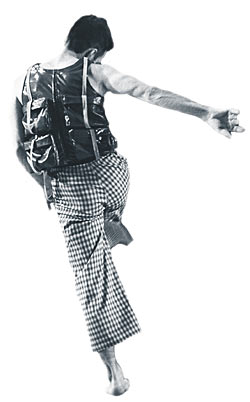Faculty concert explores movement through dance and music
Dynamic, physical movement accompanied by music ranging from live contemporary to classical will be showcased in the Fall Faculty Dance Concert presented by the Dance Program at 8 p.m. on Thursday-Saturday, Nov. 15–17, in the Margaret H’Doubler Performance Space, Lathrop Hall.

The faculty concert will feature work by guest artist in residence Jeremy Nelson.
Photo courtesy: Dance Program
The concert will feature work by New York-based guest artists in residence, Jeremy Nelson and Luis Lara Malvacias, along with choreography by Dance Program artists Li Chiao-Ping, Jin-Wen Yu, Marlene Skog and Chris Walker.
During their November residency, Nelson and Malvacias, known for their highly physical, innovative movement, will create a new group work for 10 student dancers that will be performed during the concert. The movement-inspired work will incorporate the duo’s ongoing exploration of space and spaces between things and people.
“We like to explore movement by creating spaces through which dancers have to move,” Nelson says.
“As in real life, these spaces may be confining, so you may see our dancers threading and weaving among themselves while simultaneously moving between the spaces we’ve created. To avoid collisions and accommodate others, people often end up creating their own space. And that’s when it really gets interesting,” Nelson says.
While working with students, Nelson and Malvacias will look for movement they haven’t seen before. It’s not the “do as I do” dance that trips their trigger; it’s movement created by dancers who learn to free their bodies from the inside out, which in and of itself, is a process to be learned.
Learning to connect with one’s physical being or “bodyscape” is very much in keeping with the focus of the innovative dance curriculum created at UW–Madison in 1926 by professor Margaret H’Doubler. Since then, methods such as the Alexander Technique, the Klein Technique and contact improvisation have been invoked to help people know their own bodies better.
“Our teaching is informed by all three methods and more,” Nelson says. “These techniques teach us how to experience our individual physicality and how to use our bodies most efficiently. Through this ‘freeing’ process, we become open to discovering a broader range of movement possibilities. Our quest is to explore these unending possibilities.”
While in residence, the guest artists will lean heavily on improvisational work because it often generates the desired unexpected results.
“Improv evokes spontaneity,” Nelson says. “It’s unpredictable and can often lead to movement language that’s quite surprising.”
Nelson, a recipient of a “Bessie” award for outstanding performance as a dancer with Stephen Petronio Dance Company in New York, has worked independently for the past 18 years as a choreographer, teacher and dancer. He also serves on the faculty at Movement Research in New York.
Born in Venezuela, Malvacias is a choreographer, dancer and designer as well as a visual artist. In addition to presenting his own work throughout New York, he has performed with Jeremy Nelson and with the company of John Jasperse, among others. As a visual artist, his work has been exhibited in North and South America and Spain.
Along with the guest artists’ premier piece, dance professors Li Chiao-Ping and Jin-Wen Yu will each present two works during the concert.
Li will premier “Turnaround,” a hyperkinetically paced, group work created for students. Accompanied by the third movement of Steve Reich’s imagistic, avant-garde composition “Different Trains,” the new piece takes snapshot looks at a community left to rebuild itself. “Turnaround” will also be performed at the North Central Region American College Dance Festival in March 13–16, 2008. The UW Dance Program will host the festival, which is expected to draw up to 500 students and faculty from throughout the Midwest and beyond.
Li also reprises “Residues,” choreographed in 2001 with original music by electronic composer Daniel Feiler, which explores a highly physical and risk-taking side of the duet form.
“Tiktaalik,” (tic-TAH-lick) choreographed by Jin-Wen Yu for his Freshman Repertory class, presents movement and live music performed by young artists who are debuting their talents this semester. The School of
Music’s Freshman Small Ensemble for Percussion under the direction of professor Anthony Di Sanza will play the music.
“Tony and I chose to collaborate on a performance that sets modern dance movement to contemporary American composer Robert S. Cohen’s 2006 “Tiktaalik” because we felt the challenging complexity of these energetic works will showcase the skill and vigor of our young artists,” Yu says.
In “Reflecting,” another work set to live music, Yu creates a nuanced, impressionistic ballet dance that captures the subtle, yet dazzling, phenomenon of light reflecting on water. This work for six dancers is accompanied by two of Debussy’s “Images pour piano,” which will be performed live by pianist Patrick Christians.
Music continues to play an important role in the remaining two pieces of the concert. “Troubled Water,” choreographed by Chris Walker, is set to music of the same title by African-American composer, pianist and teacher Margaret Bonds. The composition is based on the Negro Spiritual “Wade in the Water.” This recording was done by the famed Ghanian pianist William Chapman Nyaho as a part of his album Senku with piano music by composers of African descent.
The choreography explores the ideas of escape, reliability on friendship and transparency among friends.
Marlene Skog will also present a new dance for large ensemble, this one set to Bach Orchestral Suites. The light-spirited and energetic piece juxtaposed with Baroque formality is choreographed in Skog’s classic, contemporary-ballet style.
Tickets for the Fall Faculty Dance Concert are $15 for the general public and $10 for students, except on Thursday, when student tickets are $5. All tickets will be sold at the door.




